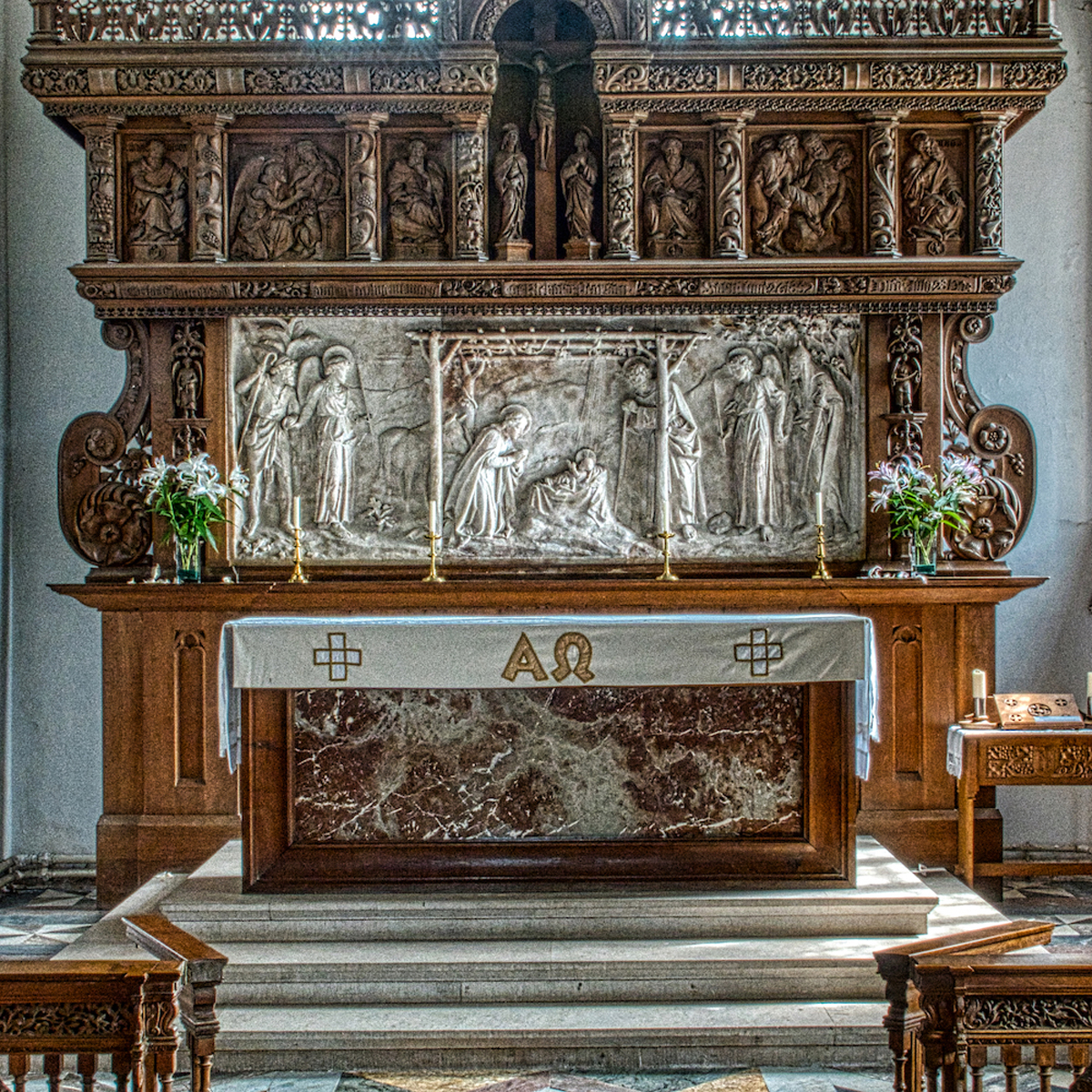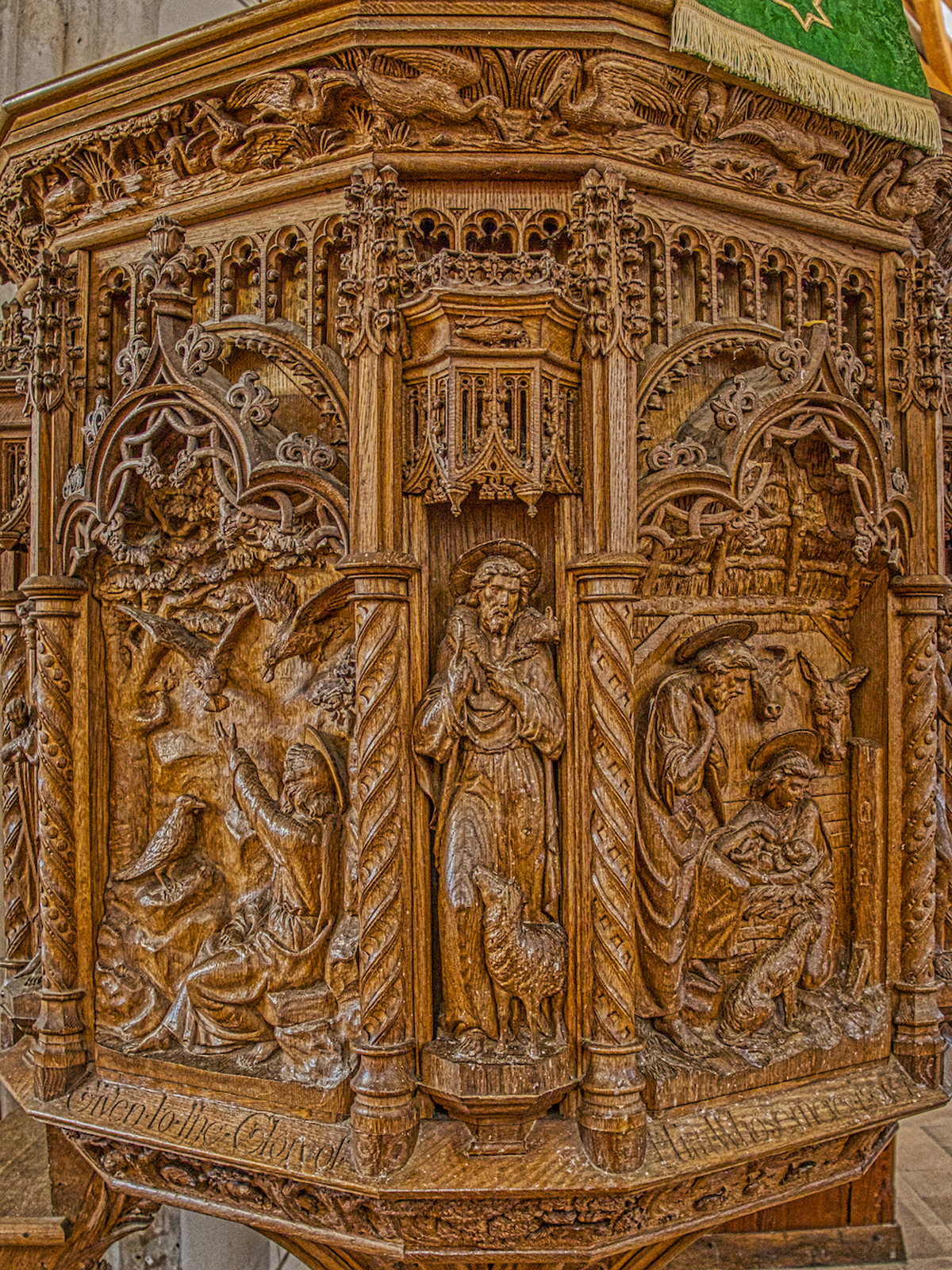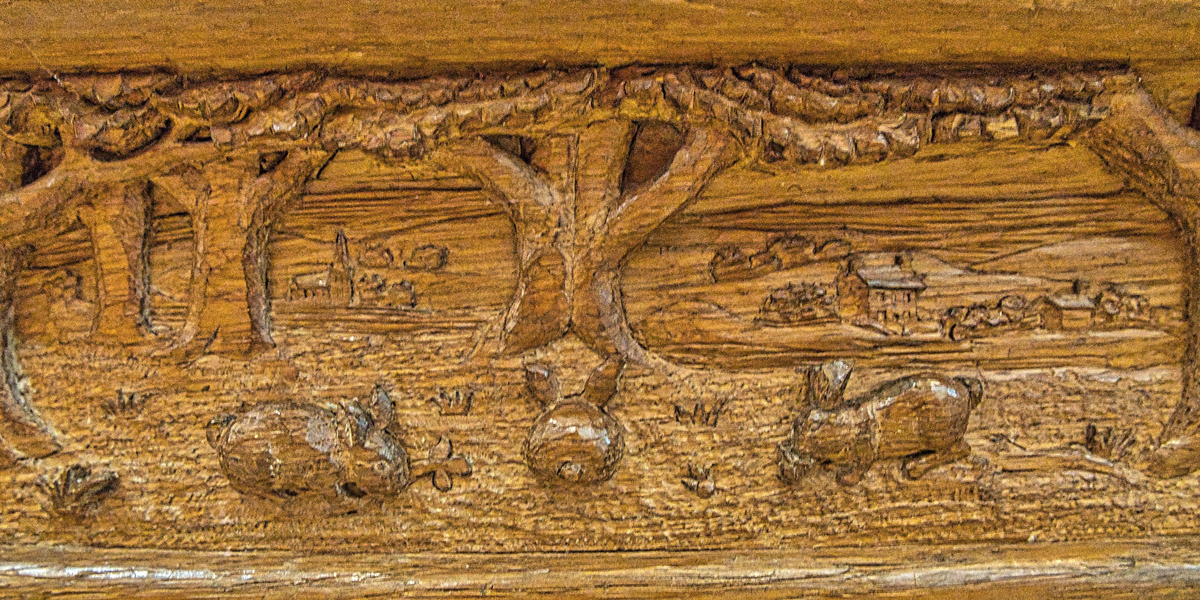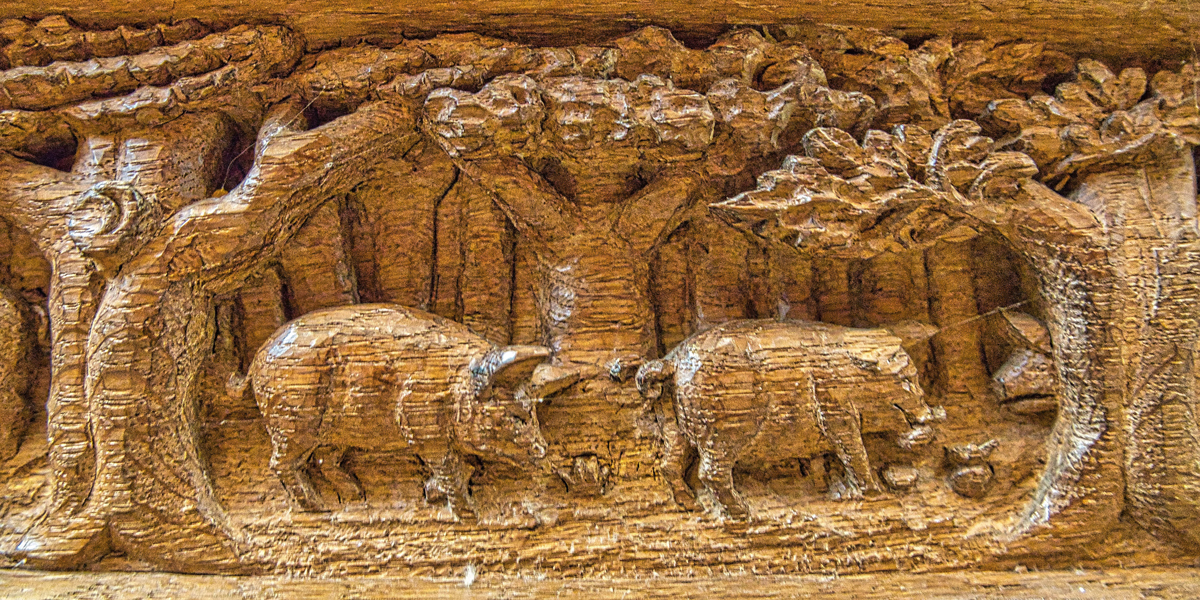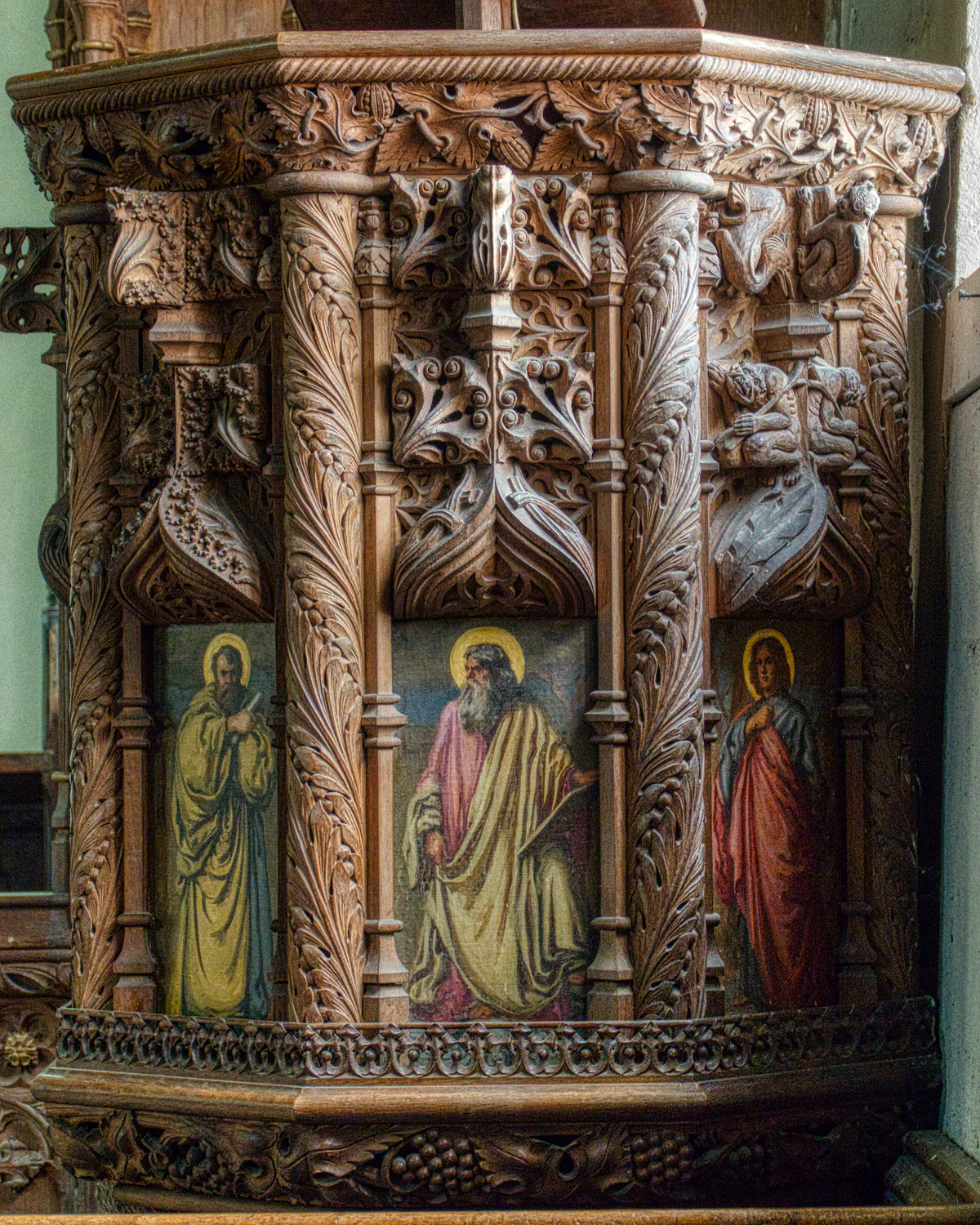Grace, Bertha, Mary, Annie (Ethel), Violet, Constance, and Ruth: the seven Pinwill sisters form one of those overflowing Victorian-Edwardian families that seemed to set alight unusual creative powers.1 Not quite as brilliant as the Darwins, nor as original as the Dodgsons, for whom Charles, later Lewis Carroll, began producing a magazine — he had seven sisters and three brothers — but in a modest way, the Pinwills made a lasting, under-recognized change to the fabric of England through their prolific woodworking skills. Mary (b.1872?) and Violet (b.1874) became the principal sculptors, but others were involved at some point and the business which they established was in effect a family business. In a recent sumptuously illustrated study, The Remarkable Pinwill Sisters, Helen Wilson has researched their lives and provided an invaluable gazetteer of their little-known work.2
In 1880 the Revd Edmund Pinwill became vicar of the parish of Ermington, a small village lying to the west of Totnes in some of the most remote countryside of South Devon. With his wife and growing family, he took up residency in the vicarage near the church and set about revitalizing the parish with his Anglo-Catholic ideas about ritual and ornament. These changes were often alien to the local community and met with resistance: Douglas Young, a historian of the West Country, comments:
The reaction against the new Oxford movement (or Tractarian) practices was perfectly reasonable, without judging on the religious wrongness or rightness of it, and the new movement was often brought in by wealthy and/or ‘foreign’ vicars without any regard for the local parish folk. Vicars had a habit of forcing through changes and part of the congregation often left to join Non-Conformist chapels because of this.3
But eventually the family and their ideas seem to have become accepted and their ideas spread from Ermington across the county and beyond, principally through the aesthetic the Pinwill girls developed. They began a woodcarving workshop based at the vicarage under the guidance of a local man, known only as ‘Giles the carver’; a local Devon architect, Edmund Sedding, advised them.4 Sedding was strongly inspired by the medieval revivalism and Gothic aesthetic of Ruskin, Pugin, and Butterfield, and under his guidance the Pinwills adorned their village church, carving statues of saints on the pulpit and Christian symbols, such as passion flowers, on its ornamental balustrade.5 Soon the young women were being commissioned across the county and farther afield.
In 1890 Mary Pinwill established a professional workshop in Plymouth, but chose to disguise the sisters’ gender and gave the business her middle name, calling it Rashleigh, Pinwill & Co., so that the firm appeared to be run by two men (Wilson, pp. 51–53). Back in Ermington, meanwhile, Violet and her sister Ethel began working independently, and after Mary married in 1900, Violet became the leading artist of the workshop, where she employed other carvers and joiners and took on apprentices. It is astonishing how much the sisters accomplished: the maps reproduced in Helen Wilson’s book show their activities densely plotted all over Devon and Cornwall, and there were invitations to make work farther afield, including London (p. 275). The Misses Pinwills’ skills can be seen in rood screens, reredos, pews, bench ends, pulpits, litany desks, choir stalls, lecterns, organ cases, altar rails, fonts and font covers, memorial tablets, and coats of arms — every kind of ecclesiastic furnishings and fittings became part of their repertoire (Figs. 1, 2).
Sometimes, Mary, Violet, and Ethel worked to Sedding’s designs, made replicas to order, and developed patterns and models for carvers in the workshop to copy. When the opportunity presented itself, they repaired and restored wrecked fragments found buried in cupboards and cellars and outhouses. But increasingly, as commissions flowed, they also followed their own imaginations and, in the spirit of the scribes and illuminators who ornamented margins with drolleries and vignettes, made up their own devices.6 A Ruskinian love of flora and fauna suffuses the Pinwills’ work, Violet’s especially. Her rural scenes arise from observation of local husbandry and wildlife — piglets and rabbits and voles and dormice and birds (Figs. 3, 4). She follows religious iconography: at the church of St Neot, in Poundstock, Cornwall, she carved the saint’s symbol, a stag drawing a plough, but she combined tradition with elements observed in the surrounding scenery: the poppy head on a choir stall in Lanteglos by Fowey shows fish swimming through seaweed; while dolphins, as seen leaping in the bays of the south coast, are shown on the cover of a font in Menheniot, Cornwall.7
I first came across the Misses Pinwills’ sculpture in the church at Lew Trenchard, another small village in the depths of rural Devon (Fig. 5). I was curious to visit it because Sabine Baring-Gould had been the vicar there and lord of the manor in the village — technically the ‘squarson’, a squire and a parson in one.8 An unusual, peripatetic, and cosmopolitan upbringing had imprinted him with a love of medieval Europe and of Catholic aesthetics. His name, however, is familiar to anyone interested in the Gothic through his activities as an antiquarian and archaeologist, collector of local tales and folklore, and writer of hymns — including ‘Onward Christian Soldiers’. His best-known works today remain The Book of Werewolves, Being an Account of a Terrible Superstition (1865) and A Book of Ghosts (1904). In spite of criticism that his scholarship is erratic, these anthologies remain rich resources and first points of call for many researchers interested in the nineteenth- and early twentieth-century supernatural.
I had not known what to expect of the tiny church, but on entering it I soon began to notice with increasing pleasure the Gothic tracery and canopies of the screen, the pulpit’s fanciful carvings, and everywhere in the church a sense of delight in ornament (Wilson, pp. 76–80). Looped and branching traditional forms — racemes and palmettes and acanthus — were entwined with wyverns and poetical animals and the occasional small grotesque figure, just as on the borders of illuminated manuscripts.
The inventive and playful woodwork at Lew Trenchard took me by surprise, and I looked up the information available. Only then did I discover that a woman artist or artists were involved. Pevsner is condescending: ‘the Pinwells’ [sic] […] workshop produced a considerable quantity of competent woodwork for churches, in the medieval tradition, but distinguished by a rather studied naturalism.’9 Of Violet Pinwill he commented, she was ‘competent if not original’ (p. 355). But for me, that women were working at all as professional woodcarvers was a revelation in itself. I was also convinced by the art’s technical dynamism and the freshness of the attack on the forms: the sisters seem truly to have answered the call of William Morris and John Ruskin to revive medieval craftwork and were practising their art as a form of address to God and a hymn of praise to nature. It is difficult to distinguish individual hands in the artefacts, but over the decades the stiffness lessens and a flowing, art nouveau-like suppleness begins to shape the interlace of screens and the mingling of flowers and foliage in the decorations.
Admiration of craftsmanship has been rising strongly in response to the urgent ecological changes on the one hand; while on the other, in counterpoise to the dematerialized realm of the cybersphere, far greater appreciation is now shown to handiwork and the haptic qualities of an artefact. The virtuoso skills of Grinling Gibbons have attracted serious attention recently: in 2021 he was the subject of a retrospective show and a monograph, while a society has been founded to celebrate 300 years since his death, and to help revive carving skills in the country.10 The exhibition interestingly included a case displaying the tools of one of his most accomplished successors in the art of woodcarving, David Esterly: dozens of chisels sharpened to particular ends for achieving precise, particular effects.11
It would be extravagant to claim that Violet Pinwill carved as finely and subtly as Gibbons, but it is possible that Pevsner, a man of his time, was unable to see a woman’s work as anything but lesser and that ‘studied naturalism’ may now seem closer to a fine aesthetic attentiveness to phenomena. Several decades on, by contrast, the Pinwills can be reassessed as belonging to the Gothic Revival, an adventurous aesthetic movement, whose products no longer appear as wildly over-decorative as they did to my eyes in the 1960s when I first saw Keble College, for example, one of Butterfield’s masterworks, or the Natural History Museum at Oxford, with its medievalizing carvings supervised by Ruskin. The Pinwills are links in a lineage running from the original medieval carvers of English cathedrals and churches to the St Ives sculptors, such as John Skeaping and Barbara Hepworth — it is significant that Violet began teaching carving in Plymouth as early as 1901 and continued doing so for over forty years.12 It may seem fanciful, but it should be possible to recognize continuity between the Pinwills’ attention to natural forms and a work of art such as the quiet fountain showing deer drinking carved by Skeaping (c. 1925) for the courtyard of the British School at Rome.13 Although Hepworth, above all, would create the language of abstraction in modern art, threads connecting the innovators of modern art to the past of craftsmanship and love of organic forms run through the Pinwills’ work. Figures like the Pinwills should be called out of the shadows, for they contributed obliquely to that revolution in aesthetics.
All her working life, Violet Pinwill would ride her bicycle to the station or hitch a ride on a delivery cart to go to her next commission, carrying sacks of wood and her bag of tools balanced on the handlebars, observing carefully the life of the hedgerows as she made her way to some medieval ruined church, where she would carve a pair of rabbits wound in convolvulus, a bird pecking at ears of corn, a cluster of cob nuts, a starburst of passion flower, or a spider in her web.
Notes
- I am beholden to Douglas Young, the creator of the inspiring website <www.devonchurchland.co.uk> for his knowledge of the Pinwills’ work, and for reading my article and giving permission to use his photographs. [^]
- Helen Wilson, The Remarkable Pinwill Sisters: From ‘Lady Woodcarvers’ to Professionals (Plymouth: Willow Productions, 2021). See also, Violet Pinwill Collection, Women’s Art Library Collections, Goldsmiths, University of London <https://archiveshub.jisc.ac.uk/search/archives/a1923bad-bb93-3cef-bce3-48e5486aac9a> [accessed 8 May 2022]. [^]
- Douglas Young, personal communication, 27 March 2022. [^]
- Young, personal communication; Wilson, pp. 67.ff. [^]
- Wilson, pp. 20–21, figs, 2.3, 2.4, 2.5, 2.6; pp. 46–47, figs 3.3, 3.4, 3.5. [^]
- See Mary Wellesley, Hidden Hands: The Lives of Manuscripts and Their Makers (London: Hachette, 2021). [^]
- Wilson, p. 86, fig. 3.53 for the choir stall, and p. 154, fig. 5.4 for the font cover. More fish and seaweeds, differently carved, appear on choir stalls in Crantock, Devon (p. 70, fig. 3.32). [^]
- Bickford H. C. Dickinson, The Parish Church St. Peter, Lew Trenchard & the Rev. Sabine Baring-Gould (Okehampton: Gti, [1965]?). [^]
- Bridget Cherry and Nikolaus Pevsner, Devon, 2nd edn (New Haven: Yale University Press, 2002), p. 107. [^]
- ‘Grinling Gibbons: Centuries in the Making’, Compton Verney, 25 September 2021–30 January 2022. See Grinling Gibbons: Centuries in the Making <https://www.comptonverney.org.uk/event/grinling-gibbons-centuries-in-the-making/>; and David Esterly, Grinling Gibbons and the Art of Carving (London: V&A Publications, 1998). [^]
- Grinling Gibbons Society <https://grinling-gibbons.org> [accessed 8 May 2022]. David Esterly’s vivid book about his life’s work is called The Lost Carving: A Journey to the Heart of Making (New York: Viking, 2013). [^]
- First at the Technical School in Plymouth and then at the School of Art there (Wilson, pp. 239–40). [^]
- John Skeaping won the Rome Prize in 1924 and Hepworth was runner-up. They married in Florence in 1925 and both attended the British School at Rome until 1926. [^]

